- 1. What Is Kanban? The Ultimate Guide to Kanban Methodology
- 2. The Core Kanban Principles and Practices
- 3. What Is a Kanban Board? Examples and Usage Guide
- 4. Everything You Need to Know About Kanban Cards
- 5. Ultimate List of Kanban Tools and Software
- 6. Practical Kanban Templates and Examples
- 7. The Complete Guide to Personal Kanban
- 8. Kanban WIP - Work In Progress Limits Explained
- 9. What Is a Kanban Retrospective Meeting?
- 10. Kanban vs. Scrum Comparison Guide
- 11. Glossary of Kanban Project Management Terms
- 12. FAQs
- 1. What Is Kanban? The Ultimate Guide to Kanban Methodology
- 2. The Core Kanban Principles and Practices
- 3. What Is a Kanban Board? Examples and Usage Guide
- 4. Everything You Need to Know About Kanban Cards
- 5. Ultimate List of Kanban Tools and Software
- 6. Practical Kanban Templates and Examples
- 7. The Complete Guide to Personal Kanban
- 8. Kanban WIP - Work In Progress Limits Explained
- 9. What Is a Kanban Retrospective Meeting?
- 10. Kanban vs. Scrum Comparison Guide
- 11. Glossary of Kanban Project Management Terms
- 12. FAQs
Kanban is one of the most popular Agile project management frameworks around, and for good reason. The Kanban methodology takes a visual approach to project management that many people find intuitive and appealing.
Plus, its emphasis on delivery can help teams improve their efficiency and increase their overall output. Online Kanban tools can help here — according to Wrike’s 2024 Impactful Work Report, 85% of businesses that have invested in new software have experienced increased efficiency as a result.
If you’re new to Kanban, this guide includes everything you need to get started. We’ll cover the basics of what Kanban is and isn’t. Then, we’ll discuss the benefits of the Kanban methodology, the types of projects it’s best suited for, how to successfully implement it, and what tools can help you succeed.
We’ll also explain how Wrike’s work management software is the best fit for your Kanban projects.
What is Kanban?
Agile is a project management methodology that promotes tackling projects by breaking them down into smaller stages. It emphasizes constant collaboration, continuous improvement, and high levels of customer involvement. There are various frameworks teams can choose to follow to adopt Agile, Kanban being one of them.
So, what is Kanban in Agile? Kanban is a project management framework that uses Agile principles to visualize workflows. Kanban uses a “pull” system to manage the flow of work, ensuring tasks progress from one stage to the next. Think of Agile as being what you want to achieve and Kanban being one recipe for how to achieve it.
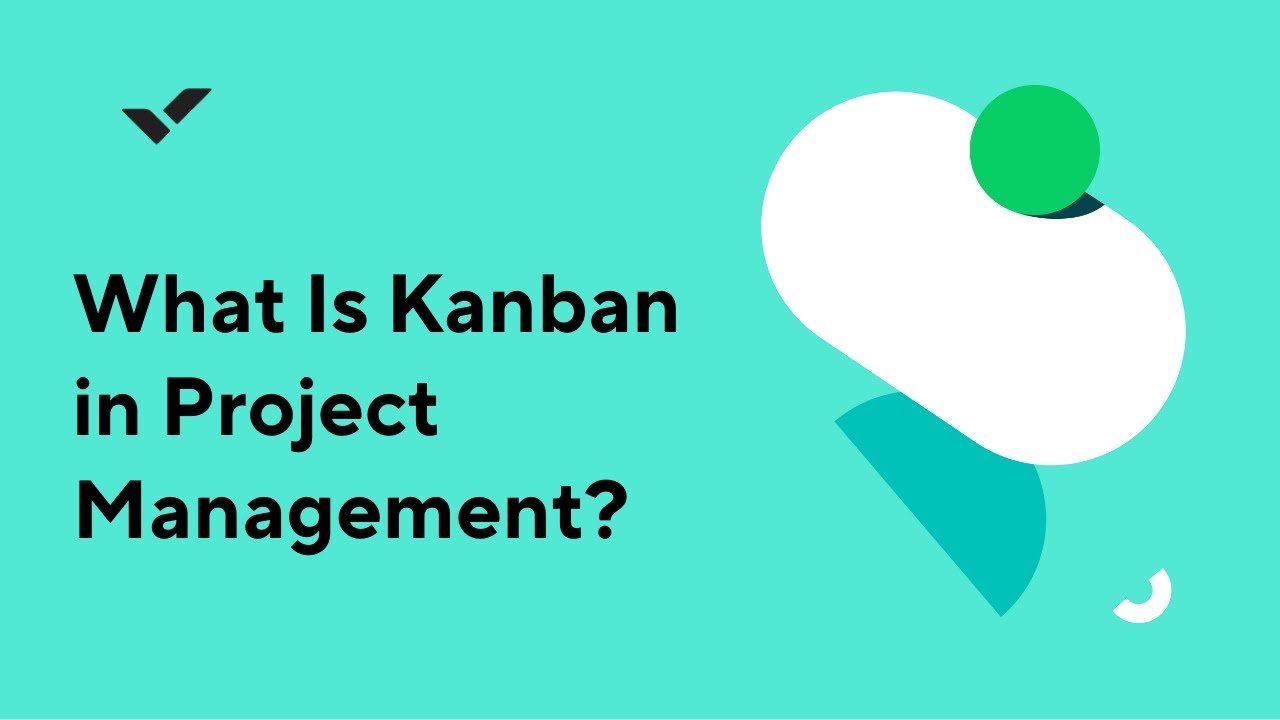
Where does Kanban come from?
Kanban originated in the late 1940s in Japan. Toyota was looking for a way to improve its engineering and production processes. One of its engineers, Taiichi Ohno, noticed that grocery stores used a “pull” method of production, stocking items based on expected customer demand to avoid having too many products on the shelf.
Ohno was inspired by this technique, which was later developed into “just-in-time” production and implemented into the Toyota factory in 1953 as an early approach to Lean manufacturing. The Kanban process was the result of this adaptation.
“Kanban” is a Japanese word that roughly translates to “card you can see.” Toyota used physical cards to signal separate steps in their manufacturing process. These cards enabled team members to easily see what was completed and what still needed to be done.
It wasn’t until the early 2000s that Kanban started to take root in project management. David J. Anderson is often credited as being the first to implement Kanban in software development in 2005. His book on Kanban, published in 2010, is still one of the most comprehensive resources out there for technology-focused projects.
Since then, the Kanban Agile methodology has continued to evolve to suit projects across all industries and markets.
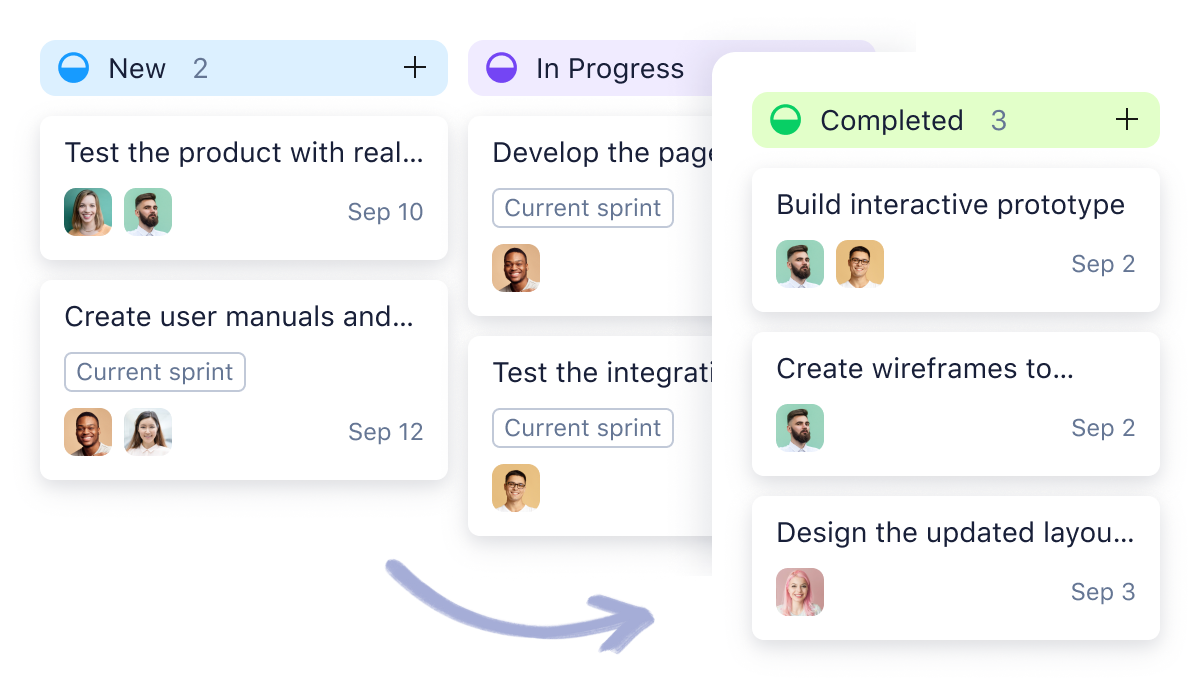
What are the fundamentals of Kanban?
Kanban is about more than using cards to help manage just-in-time delivery. The Kanban framework is designed to help teams reduce bottlenecks, improve efficiencies, increase quality, and boost output. There are believed to be four foundational principles of Kanban.
4 principles of the Kanban methodology
- Start with now. Focus on what you’re doing now. Fully understand the processes already in place, including what works and what doesn’t.
- Take an incremental approach. Look at how to slowly change your processes over time. Avoid implementing radical changes.
- Keep roles. Unlike other frameworks that promote their own unique roles (such as Scrum master), Kanban emphasizes working with the roles your team already has.
- Encourage leadership. Innovation and ideas for improvement should be promoted at all levels. Encourage every employee to act as a leader, regardless of role or title.
According to the David J. Anderson School of Management, there are also six core practices in Kanban.
6 core practices of Kanban methodology
- Visualize the workflow. Kanban requires using a physical or virtual board to visualize how work flows from one stage to the next.
- Limit work in progress. Each project team needs to set a limit to how many tasks are allowed to be in each stage of the workflow at once. If you have five reviewers, you may limit the “Review” stage to having no more than five tasks in it at once.
- Actively manage the workflow. As a project manager, your primary role is to monitor the workflow for bottlenecks and make adjustments to remove roadblocks and improve efficiency.
- Create process guidelines. Have clearly communicated process policies on how each work item is completed, what “done” means, etc. This can be a checklist in each column or on each “card” outlining what is required for it to move to each stage.
- Use feedback loops. Use tools and processes to promote early and continual feedback. This can mean multiple review stages, or reports and metrics communicating performance.
- Evolve. As with other Agile frameworks, adapting, evolving, and improving your processes is encouraged. Focus on developing and implementing small changes to improve your workflow and processes.
What is a Kanban board?
The Kanban board is a physical or virtual board that maps out your project’s workflow and how tasks move through it from beginning to completion. The board tracks each work item as it progresses through various Kanban stages. A Kanban board ensures the workflow is standardized, and that team members can easily see where each task is in the overall scheme.
The most basic Kanban board only has three workflows:
- To Do
- Work In Progress (WIP)
- Complete
However, columns can also be added or changed to suit your project depending on the Kanban board software you use.
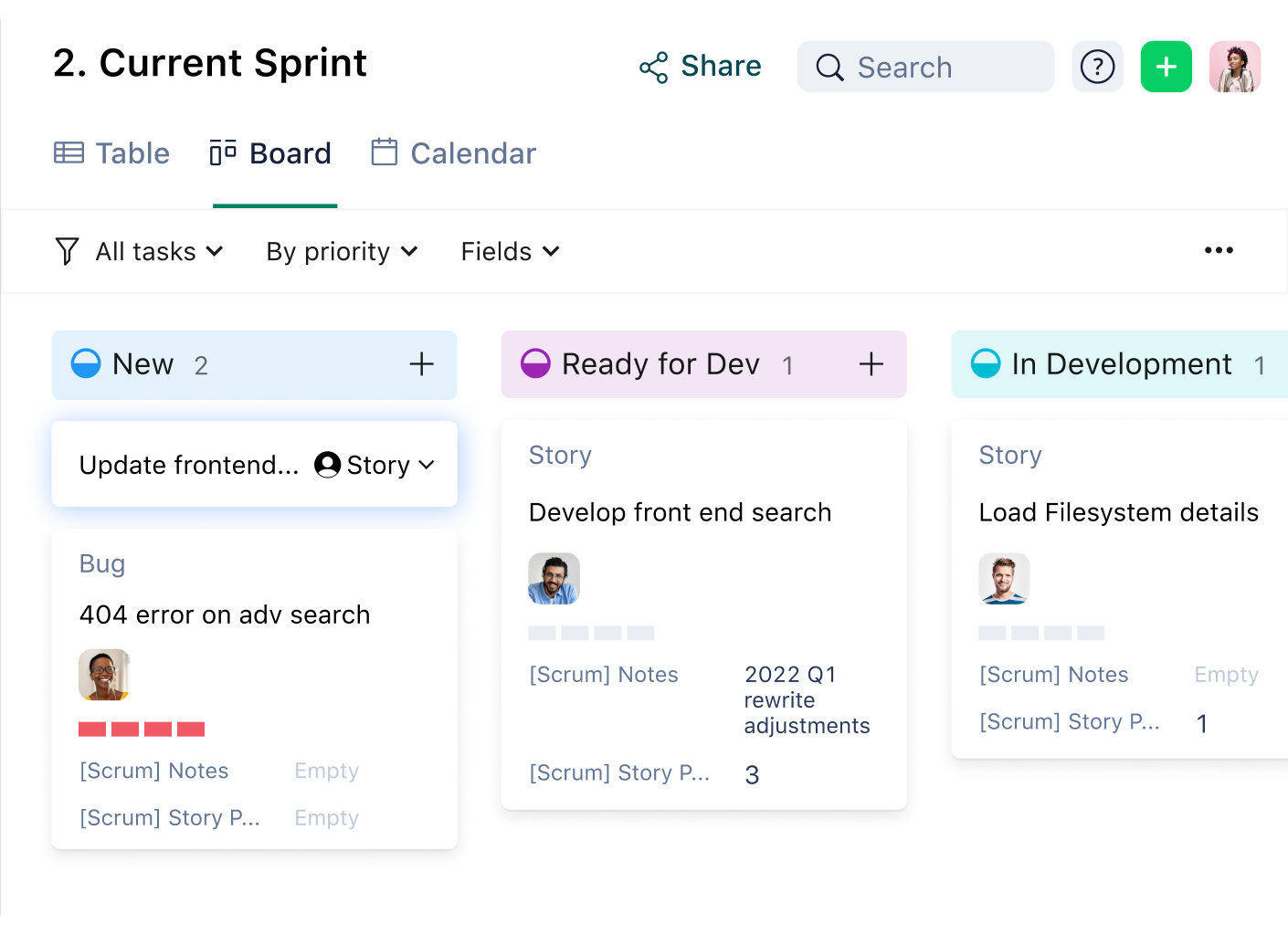
Each task is represented as a “card” or “sticky notes” and placed on the board in the column representing its current stage of work. As tasks progress, the card is moved throughout the workflow. Kanban cards contain information about the task, such as:
- A short description
- The name of the person responsible
- An estimate of how long it will take
- Requirements to move it to the next stage
Virtual cards may also contain other data, including links to relevant documents and supporting files. If you’re on a budget, there are free Kanban tools (like Wrike) that make it easy to get started without extra costs.
How is Kanban methodology different from Scrum?
Scrum is another extremely popular Agile project framework. As both Kanban and Scrum are based on the Agile project management methodology, they have similar principles and ideals. Scrum and Kanban encourage:
- Collaboration
- Process improvement
- Breaking projects down into phases
However, there are essential differences between the Kanban and Scrum frameworks.
Differences between Scrum and Kanban
Kanban | Scrum |
Focuses on breaking a project down into workflow stages and managing the flow and volume of tasks through those stages. | Scrum revolves around breaking a project down by time (usually “sprints” that last one to four weeks) and managing tasks completed in each sprint. |
While cards may have deadlines or estimated times to complete, the Kanban system is viewed as a continuous flow. | Scrum follows strict sprint deadlines for completing tasks within each sprint. |
Often used by IT service desks that have a never-ending flow of tasks. | Commonly used by software development teams that require specific deliverables. |
The Kanban framework encourages focusing on keeping the roles your team already have. | Scrum has several unique roles, such as Scrum master, product owner, etc. |
Kanban board methodology better suits teams with a continuous influx of new tasks. | Scrum is better for time-sensitive projects. |
And here’s a video overview that goes into the differences between Kanban and Scrum, as well as the similarities, in more detail:
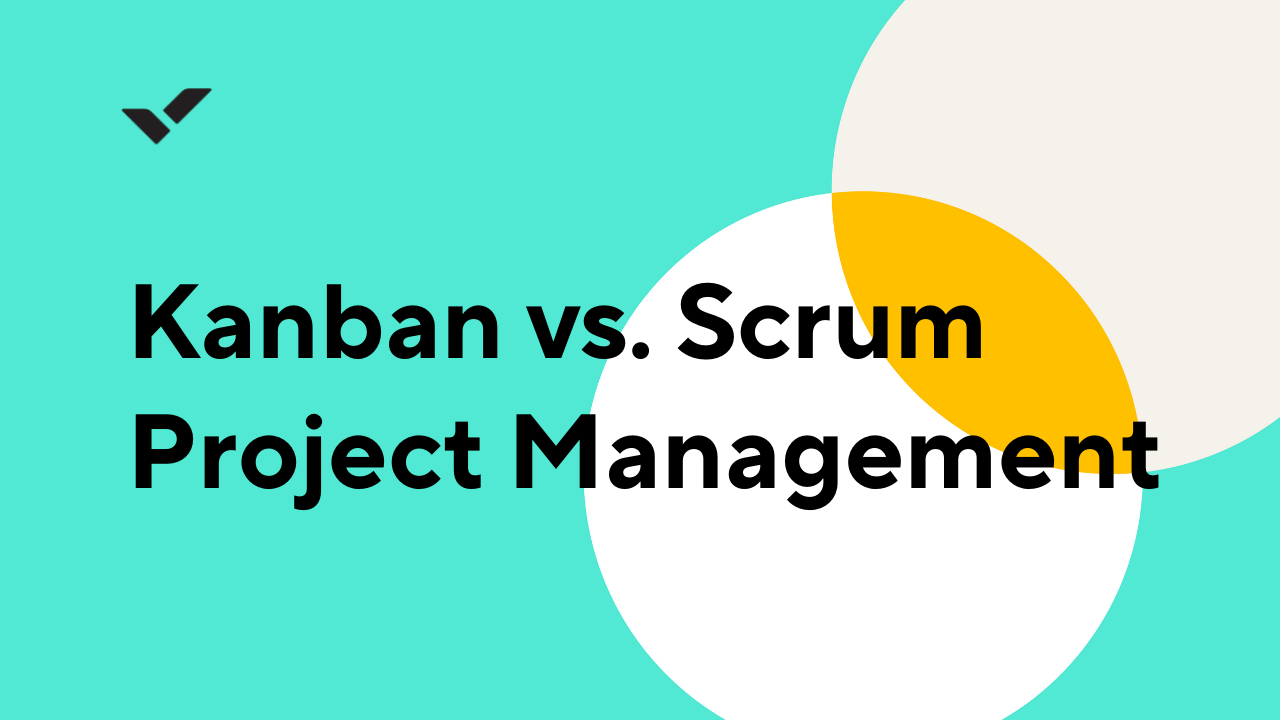
Many teams are now adopting a fairly new framework called Scrumban that attempts to capture the best of both worlds.
What are the benefits of Kanban?
The primary benefits of the Kanban methodology are:
- Flexibility: Kanban doesn’t dictate which work occurs when, simply, how many tasks are allowed in each phase at once. This approach makes it incredibly easy to reshuffle work as priorities change.
- Fewer bottlenecks: Kanban boards help you quickly identify bottlenecks in the process so you can discover and resolve what’s slowing down your team.
- Increased efficiency: While Kanban doesn’t have a set schedule, a key metric is often the average time it takes for a task to complete the workflow. This emphasis on how quickly or slowly tasks move through phases can help your team increase efficiency and speed up output.
- Better quality: By limiting the number of tasks your team can work on at once, the Kanban method helps you improve their focus and the quality of their work.
- Faster adoption: Kanban encourages starting with your current processes and roles and making small changes. This approach helps Agile teams embrace the change more easily.
- Visibility: Anyone can look at your Kanban board and quickly see what stage a task is in and who is working on it.
- Continuous delivery: As with other Agile principles, Kanban emphasizes delivering workable solutions on a regular basis. This approach shortens delivery times and helps improve customer relationships.
What types of projects is Kanban best for?
Kanban project management is best for projects that have a lot of individual deliverables and an emphasis on workloads over delivery dates. Because an individual card represents each task, projects with a lot of interdependencies may suffer.
However, suppose you’re dealing with a large volume of tasks that have multiple discrete statuses, with a different person responsible for each one. In that case, Kanban helps you effectively monitor each stage of the process.
Some examples of projects that do well with Kanban are:
- A marketing campaign requiring many separate ads
- A content creation project, where each blog, chapter, or story is a separate task
- A service project to resolve bugs and close out customer tickets
6 ways to introduce Kanban-style project management
Implementing a Kanban system is all about incremental progress; it isn’t meant to be a static framework that stays the same forever. The core principles of Kanban tell you to start with whatever you’re doing now and slowly implement changes over time.
To introduce Kanban project management to your project team, you can start slowly incorporating it into what you’re already doing. Here’s a step-by-step guide to help you get started:
1. Document your current process
Start by documenting your current processes and identifying the work stages your team uses, such as:
- To Do
- In Draft
- In Review
- Approved
Next, create a Kanban board to visualize this workflow. You can use our template to help you.
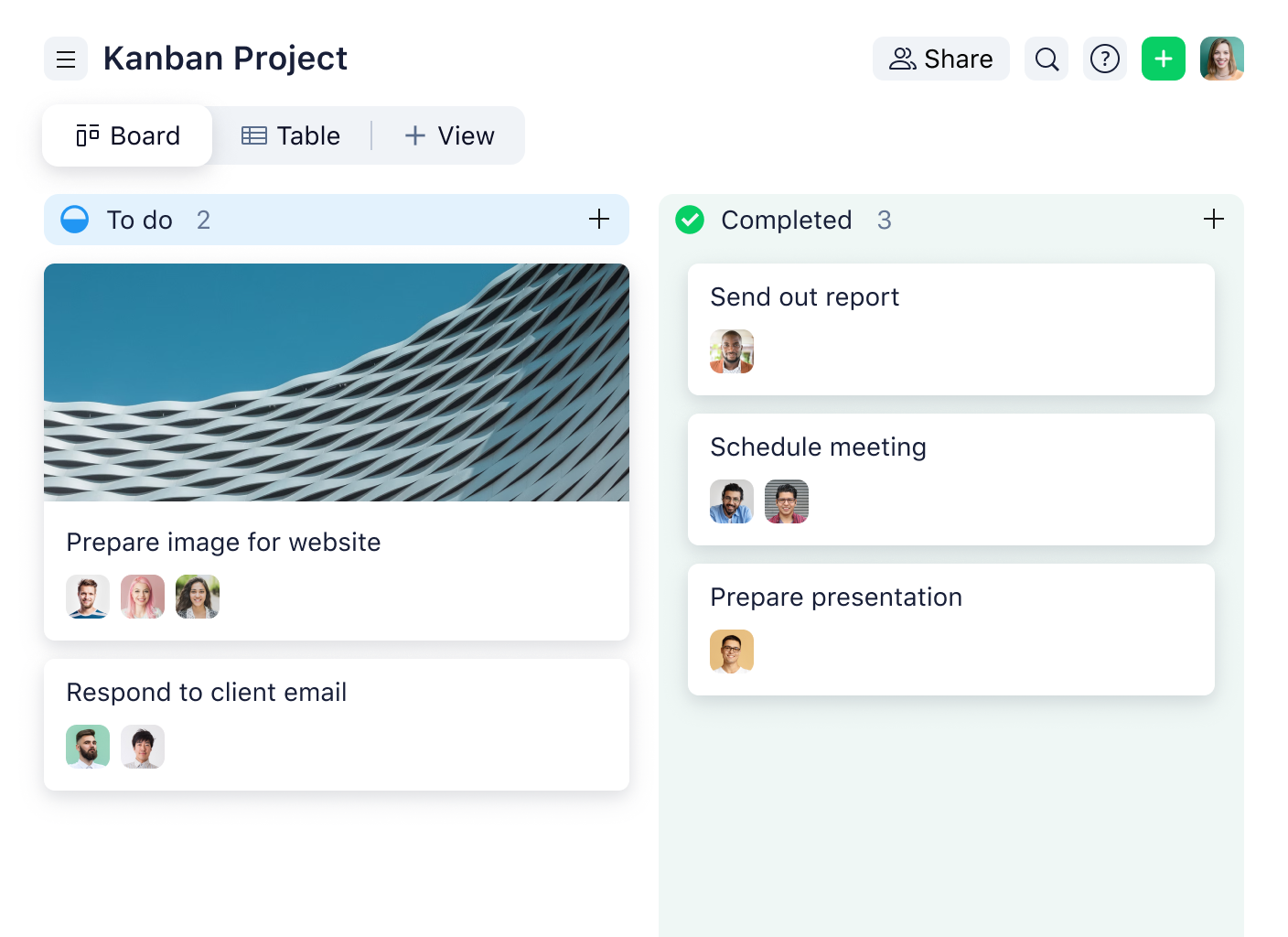
2. Set work-in-progress limits
Once you can see your workflow, it’s time to analyze how efficient your team is, look for bottlenecks, and set some work-in-progress limits. See how many tasks are going through each stage without limits, and where they are getting bogged down.
Then, set limits and monitor how they change performance. If you end up with idle people, you can either increase your limits, reallocate work, or look for what’s causing some phases to move faster than others.
3. Create process guidelines
If you don’t have clear guidelines already about what each stage means and when it’s ready to move on, it’s time to create those outlines. If you’re using Kanban project software, you can create a checklist or overview for each stage of the workflow. This improves the overall process and helps the team to complete tasks more efficiently.
4. Implement feedback loops
The next step will be to implement short feedback loops. You can do this by introducing daily meetings, review stages, or reports and dashboards showing key metrics, such as cycle time (the average time it takes for a task to complete the workflow) and lead time (total time taken from when a task is initiated until it’s completed and delivered).
5. Encourage continuous improvement
As your team slowly adopts more Kanban processes, encourage them to speak up about what works well and what could be better. Prompt them for suggestions on how to improve and promote them to take on a leadership mindset.
6. Measure progress
Track progress and performance and be ready to adapt and change as you and your team discover new and better ways to do things.
Break down projects into visual representations in Wrike
Now that you’ve learned all about the Kanban methodology, it’s time to put that knowledge into action using an all-in-one work management software like Wrike.
With Wrike, teams can manage their Kanban work and monitor every step in the process. If you’re implementing Agile in your projects, Wrike’s Kanban boards allow you to set up specific Kanban phases that match your workflow.
You can also:
- Customize our Kanban project templates
- Use shared dashboards to collaborate seamlessly
- Generate reports on your progress
- Automate repetitive tasks
Need a better way to visualize projects? Start your free two-week trial of Wrike today.

Alex Zhezherau
Alex is Wrike’s Product Director, with over 10 years of expertise in product management and business development. Known for his hands-on approach and strategic vision, he is well versed in various project management methodologies — including Agile, Scrum, and Kanban — and how Wrike’s features complement them. Alex is passionate about entrepreneurship and turning complex challenges into opportunities.

